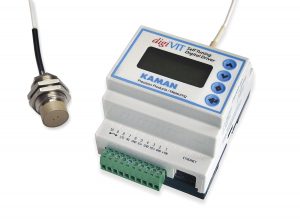By Will Meenan, Kaman Precision Products
More and more industries and manufacturers are requiring sensors for condition monitoring in their machines or processes. New digital signal conditioner technology is now available that simplifies the use of eddy current (inductive) displacement sensors for high precision/high reliability applications. The technology is the best option for monitoring movement, position, vibration, alignment, or deflection, especially where parts operate in high temperatures or within environmental contaminants. Unlike previous versions that required circuit modifications and manual calibration to match the required target, sensor, cable length, and range, the new digital signal conditioners configure themselves in a matter of minutes. In addition, the technology works with a wide variety of sensors.
High performance sensing options needed for condition monitoring
Many sensor options are available for machine condition monitoring, including inductive technology, linear variable differential transformers (LVDTs), laser triangulation, capacitive, and ultrasonic systems, as well air gauging, Hall effect, and optical systems. Each technology has distinct advantages and disadvantages, depending on the application.
Eddy current sensors are generally much more insensitive to environmental contaminants than other options. They operate on the principle of impedance variation caused by eddy currents induced in a conductive target by a sensor coil. The sensor coil is excited by a high frequency oscillator, which generates an electromagnetic field that couples with the target. Signal conditioning electronics sense impedance variation as the gap between sensor and target changes and translates it into a usable displacement signal. This technology provides extremely high (sub-micro inch) resolution.
Eddy current sensors can “see through” non-conductive materials, making these sensors useful in such applications as paint, rubber, and paper thickness. They can also be a good option for operation over a wide variety of temperatures and environments, including dust, oil, gas, diesel fuel, liquid oxygen, and rocket fuel.
Inductive technology is used for many higher performance sensor applications, especially those needing higher frequency responses in challenging environments and temperatures. They allow operators to monitor a machine and determine when it has to be taken offline for maintenance. Conversely, the sensor may indicate that the machine is running well, so maintenance is not yet required. If, for example, the machine in question is a critical pump operating in an inaccessible location, precise information on machine condition can be critical to a company’s bottom line.
High precision inductive sensors can also be used to monitor or control the quality of a process. The sensors provide a real time control signal to the machine or a display to the operators so they can adjust machine performance.

New self-configuring inductive signal conditioner technology
Previous signal conditioner technology required hardware or software configuration to accommodate different sensors, target materials, cable lengths, and range. This was more costly and time consuming to set up.
New digital signal processors, including digiVIT, simplify the use of eddy current sensors for high performance applications.
Calibration is performed by menu options and push buttons on the front panel as opposed to adjustment of analog potentiometers. Reconfiguration, if required, can be performed in a matter of minutes. A highly linear output signal is achieved internally using digital linearization techniques. Temperature compensation of the
output signal, desirable to minimize measurement temperature effects, is performed by the internal microprocessor and can be easily set up by the user, in many cases in-situ.
The digiVIT signal conditioner also includes user programmable functions, including:
Examples where digiVIT has been used for applications requiring precision and ease of use
The digiVIT is suitable for applications requiring precision and ease of use at a reasonable price. Some customer examples include:
High precision but easy to use
No other signal conditioner allows users to easily work with such a wide variety of measuring system configurations and operating conditions. For applications where high performance is a must, the new digital signal conditioner technology is an attractive option.